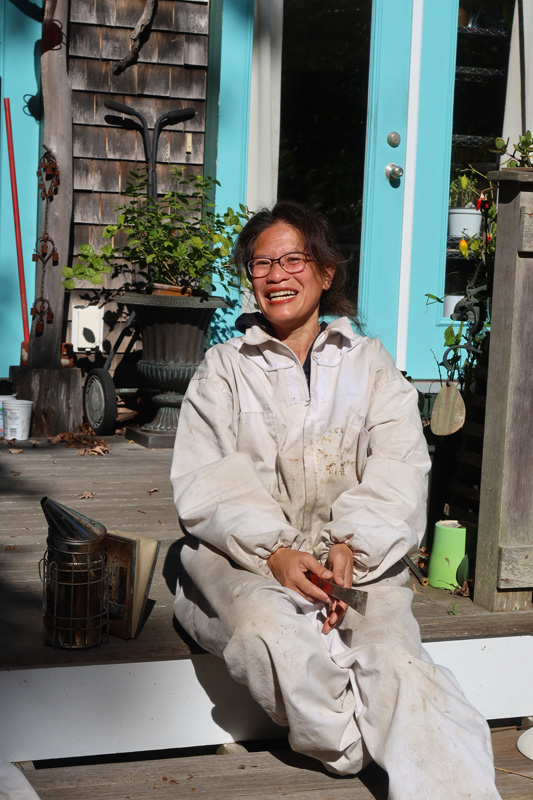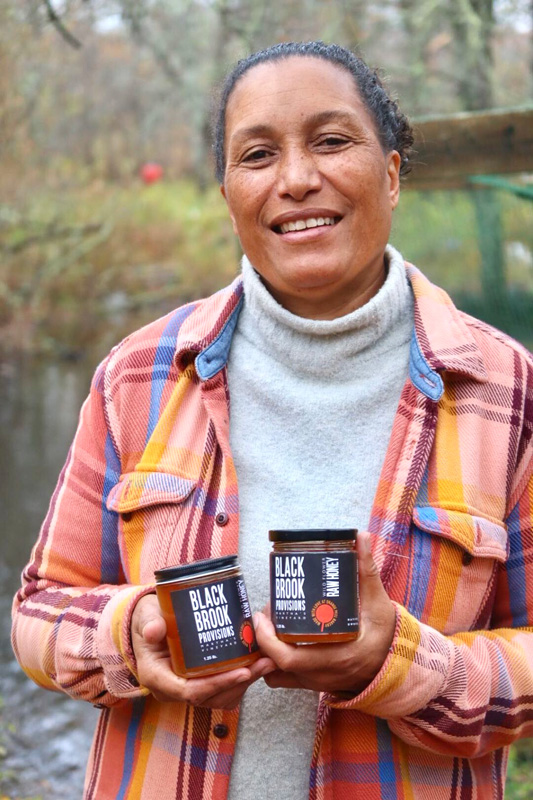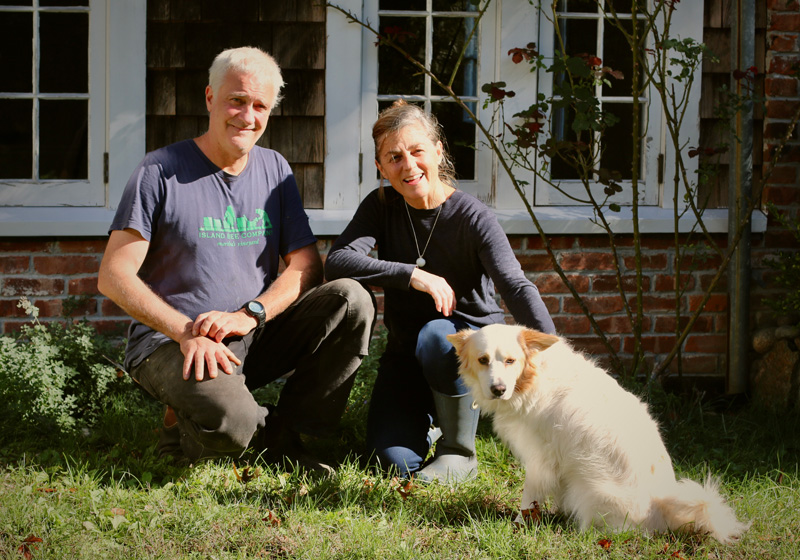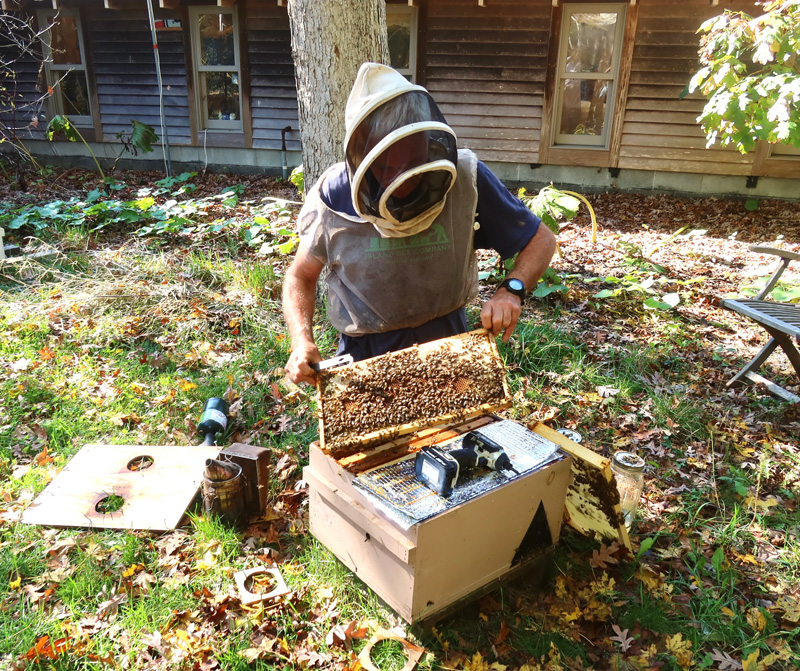Winter is a quiet time of year for bees, but when spring comes, they’ll be buzzing in trees, flowers, and gardens all over the Island, thanks to a growing number of dedicated local beekeepers. Beehives can be found beside wide-open fields and on little half-acre lots, and the bees’ health relies on a steady supply of nectar through the growing season, and careful tending by their beekeepers. Challenges include drought, like this past summer’s, which dries up the nectar of flowers, and the dreaded Varroa destructor mite. But if the bees do well, there’s honey in the end for the beekeeper, with well-pollinated gardens along the way.

Nina Gordon first thought about keeping bees after some local honey she bought turned out to be not so local after all. “I thought, What do I have to do to get actual local honey, keep bees?” she says. Years later, when her younger child went to college, she finally had a little extra time to pursue a hobby. A friend of hers gave her their old equipment, which helped her get started; a smoker, bee suit, and hive. But when she tried to order bees, she found out that it was too late in the year — you need to order bees in February or March. Nina spent the next year reading and studying, learning a lot before she brought her first bees home.
Now she keeps a couple of hives in her yard, and helps a few other people with their hives too. She looks into the hives once a week during the warm part of the year, checking them for signs of trouble, to see how the bees’ honey supply is doing, and to take out any bees that aren’t doing well. “I don’t think of bees as individuals,” she says. “The colony is the organism, and it reproduces by swarming. They don’t mind sacrificing themselves to save the queen and the colony.” Nina wears a jacket and hood to protect her face, but no gloves. Gloves make it a little harder for her to work smoothly, and being clumsy around the hive can agitate the bees, which is the opposite of what she wants. She looks over the cells to see the pattern in the brood the queen has laid, and whether it’s developing as it should. In the spring, she checks to see if the hive is getting ready to split and swarm, which she tries to avoid. “Swarming bees may make hives in inconvenient places, like neighbors’ houses,” Nina says.

Sometimes wild bees make hives on the Island, too. Juli Vanderhoop has been keeping bees in Aquinnah since someone gave her a few hives about 13 or 14 years ago. She adopted some wild bees this year — a swarm had set up its hive inside the wall of a neighbor’s house. They had to cut the wall to get the colony of bees out and into a hive box, and Juli is now looking forward to seeing how they’ll do through the winter. “I’ve just gotten further and further into the study of bees,” Juli says. “I’m constantly wondering about what my bees are into.” One spring, she had so many bees on her maple tree that it was vibrating. “That maple sugar in it was very attractive to the bees, and they were just all over it. It’s a rare type — it’s grown much larger than I had expected it to.”
Bees feed on different flowering plants at different times of year, from flowering trees to blueberry bushes, and late in the summer, on goldenrod and knotweed. Nina says that some of the most delicious honey she’s tasted came from a hive near a cranberry bog. Goldenrod honey is dark and strong-flavored, and it’s good for the bees to keep it to feed on in the winter.
While some beekeepers get started through gifts from friends or a passing curiosity, for others it’s a family legacy. When Ben Cabot’s uncle, Andy Boass, passed away unexpectedly in 2015, Ben and his kids took over Andy’s hives. Ben keeps a hive at his house in West Tisbury and one at his uncle’s old house, and also takes care of half a dozen hives at Beetlebung Farm in Chilmark. The drought and the heat this summer were hard on his hives in West Tisbury, but the ones at the farm thrived because the irrigation there gave blossoming plants plenty of moisture. The grove of beetlebung trees just next to the hives helped, too. “Every hive is different, every year is different,” he says. He coordinates with several other local beekeepers to order bees, including Garrison Vieira, who is a sergeant in the West Tisbury Police Department, and vice president of the Martha’s Vineyard Agricultural Society. Garrison got started in beekeeping about 12 years ago. “My dad did it for a year or two, and my mom kept the stuff. I decided to try it,” he says. It was a way to reconnect with his father, who had died when Garrison was young. He laughs at the idea of selling the honey from his bees. “My wife and girls go through it like it’s going out of style,” he says, but occasionally he might give a jar of honey as a gift.


Tim Colon of Island Bee Co. got started in beekeeping because one of the cabinetmakers he worked with had hives. He started doing it at home, and his kids would sell the honey on the street. In 1999, Tim and his wife Tricia took over a farmer’s market stand from beekeeper Neil Flynn. Now it’s a thriving family business that keeps him busy full-time for much of the year. Tim has about 80 hives around the Island, and is hoping to add more, but not too many. Even though he’s been keeping bees for decades, there’s always more to learn. He is currently one of 200 beekeepers in New England in a program run by Penn State University, to learn about queen rearing and artificial insemination of bees. The group meets online every other week for an hour, with guest speakers.
Cooperation and continuing education are vital for all beekeepers. Nina and Juli are part of a small bee club that they call the Buzz Buddies, about eight Island beekeepers who help one another and learn together. They’ll get together to open up hives and see what’s happening in there, whether the brood cells are going to be drones or workers, if the hive looks healthy, and if it needs to be treated for mites. “A lot of information is passed back and forth, and it’s been great,” Juli says. They sometimes get together for honey tastings, and to physically help each other — a hive box that’s full of honey can weigh 40 to 50 pounds, so there’s some heavy lifting involved.

Ben Cabot joined a Plymouth-based beekeeping group, which he finds a great resource for knowledge and advice. When Garrison was a newer beekeeper, he had Kim Skyrm, the state apiary program coordinator, come to inspect his hives and make sure that he was on the right path, which he found very helpful. Recently he has helped to set up classes and hive inspections for Island beekeepers by the Massachusetts Department of Agriculture, through the M.V. Agricultural Society.
Every beekeeper I spoke with stressed the importance of responsible beekeeping. “They need help,” Juli says. “If someone has an untended hive, that will spread disease.” Tim is even more adamant about responsible beekeeping: “People who don’t take care of their hives encourage the Varroa mite, which is a huge vector of disease, and spread the mite and its viruses to other bees,” he says. Nina likens the Varroa mite to ticks — not great in themselves, but most dangerous for the diseases they carry. An overpopulation of honeybees can threaten local pollinators, which can be a concern in highly populated areas.
Beekeeping isn’t for everyone — it takes work, there’s the risk of occasional stings, and some hives don’t make it through a winter, struggle to find food during a dry summer, or fall prey to mites or other pests. Then again, there’s the cheerful buzz of bees in the yard, and honey, lighter-colored in the spring, darker in the fall, taking on the flavors of the plant world, from light clover to rich chestnut, a spectrum of tastes that reflects the landscape all around.

